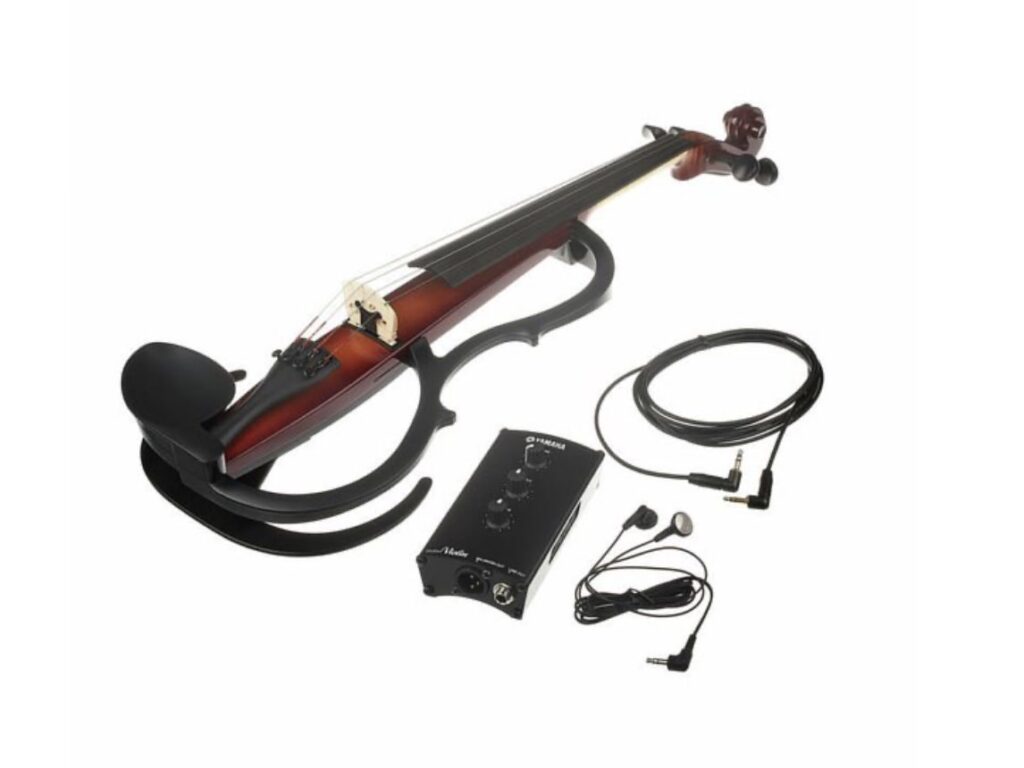How Much Does a Violin Weigh? With a great table in g and lb
When considering the weight of a violin, one must appreciate that it is not just a matter of how heavy the instrument is, but how this weight affects playability, sound quality, and the physical demands on the musician. The violin is a delicate balance of craftsmanship and ergonomics, evolving through centuries to deliver sound that is as rich as it is resonant.
The average weight of a violin ranges between 400 and 600g (0.88-1.32lb). Weight can influence sound, but not systematically, but weight affects playability.
But there is much more to it. Is the weight significant for sound? Is it particularly tiring to play with the wrong instrument? I think we should find out..
How much does a violin weigh at any size?
Violins come in various sizes, accommodating the smallest child to the full-grown adult. A full-sized (4/4) violin generally weighs between 400 to 600 grams (0.88 to 1.32 pounds). Fractional sizes, such as 3/4 and 1/2, are proportionally lighter. Violas, larger and tuned a fifth below the violin, vary more significantly in weight due to their varying sizes. Still, a typical full-sized viola can weigh between 450 and 700 grams (0.99 to 1.54 pounds). The five-string violin, a hybrid of the violin and viola, usually has a weight closer to that of the viola due to its larger size to accommodate the extra string.
Here’s a comparative table of violin weights for reference:
| Instrument | Size | Weight Range |
|---|---|---|
| Violin | 1/16 | 120-150g (0.26-0.33lb) |
| Violin | 1/4 | 280-340g (0.62-0.75lb) |
| Violin | 1/2 | 320-400g (0.71-0.88lb) |
| Violin | 3/4 | 380-460g (0.84-1.01lb) |
| Violin | 4/4 | 400-600g (0.88-1.32lb) |
| Viola | 12-inch | 430-480g (0.95-1.06lb) |
| Viola | 15-inch | 450-550g (0.99-1.21lb) |
| Viola | 16-inch | 500-700g (1.10-1.54lb) |
| Five-String Violin | Variable | 450-700g (0.99-1.54lb) |
Are lighter or heavier violins better?
Advantages of a lighter violin
The question of whether lighter or heavier violins are superior is a nuanced one, as the “better” choice largely depends on the individual player’s preference and physical comfort. A lighter violin can be advantageous for young students or those with smaller frames, as it reduces the strain on the neck, shoulder, and arm, allowing for longer practice sessions without discomfort. It is also often easier to maneuver, facilitating quick technical passages and complex pieces.
Advantages of a heavier violin
Conversely, some players may find that a heavier violin offers a feeling of stability and substance, potentially contributing to a richer or more grounded sound. The added mass can help in the production of a fuller tone, particularly in the lower registers.
However, the weight of a violin does not directly correlate with sound quality. The craftsmanship, materials, and design of the violin play a far more significant role in its tonal characteristics. Moreover, the balance of the instrument, rather than its sheer weight, is critical for playability. A well-balanced violin, whether light or heavy, will feel more comfortable and responsive in the hands of the musician.
Ultimately, the decision between a lighter or heavier violin should be informed by the player’s physical comfort, ease of playability, and sound quality produced by the instrument in their hands. The deciding factor is personal preference, shaped by the unique interaction between the musician and the instrument (and the bow).
Is weight important for sound?
Weight can influence the sound of a violin, but it is not the sole determinant. The type of wood, the thickness of the plates, the varnish, and the skill of the luthier play significantly more critical roles in the sound production of the instrument. However, the weight distribution across the violin can affect its resonance and response. A well-balanced violin, regardless of its weight, is typically considered ideal.
How weight can influence the sound of a violin
The weight of a violin is determined by:
- the type of wood
- the age of the wood (dry vs green wood)
- thickness of the table and bottom
- type and nature of accessories
So, thicker and heavier wood can give better sustain and better high-pitch harmonics: harder wood vibrates more quickly and amplifies higher frequencies naturally.
Thinner and lighter wood gives deeper notes and lower pitches.
The weight of a violin can influence its sound, but it is not a primary factor in determining the instrument’s tonal quality. The way a violin produces sound is a complex interplay of its materials, construction, and the skill of both the luthier and the player. The density and distribution of the wood, the thickness of the top and bottom plates, the type of varnish, and the tension of the strings are far more consequential in affecting the sound.
A violin’s weight may subtly affect its resonance and sustain. Heavier violins, with more mass, can offer a more profound and richer tone, particularly in the lower registers. They may also sustain notes longer due to the additional mass of the wood resonating. On the other hand, a lighter violin might respond more quickly to the player’s touch and can produce a brighter tone.
The importance of a good weight distribution for a violin
The distribution of the weight across the violin is critical. An instrument that is top or bottom-heavy can be more challenging to play and may affect the sound by making it harder for the violinist to produce a consistent tone. The balance point between the scroll and tailpiece, the fit and weight of the bridge, and even the weight of the tuning pegs can all subtly affect the sound.
While the weight of a violin contributes to its overall character and can influence the sound, it is less significant than the craftsmanship and material quality.
If it was that simple: every violin would weigh exactly the same weight as a Stradivarius violin, and everything would be perfect.
Everything has to be in balance: not too thin nor too thick.
Is playing the violin physically demanding?
Playing the violin is indeed physically demanding, a fact that may surprise those unfamiliar with the intricacies of this stringed instrument. Unlike some instruments that rest on the ground or against the body, the violin requires a delicate balance and constant tension between the chin, shoulder, and hands to maintain its position. This posture, essential for control and sound production, demands significant endurance and muscle control from the violinist.
The position of holding the violin is not inherently natural or comfortable. The left arm must be elevated, the fingers precisely placed on the strings, and the neck and shoulders must remain in a fixed position to support the instrument. This can lead to tension and strain, particularly in the neck, shoulders, and back. Moreover, the fine motor skills required for the rapid, intricate finger movements on the fingerboard and the bowing technique can place a significant strain on the muscles and tendons of the hands and forearms.
I remember when I started, like every young violinist, I’ve found very hard to hold the violin up in the air and my arm was quickly tired.
I couldn’t hold the violin with my chin yet, and everything rested on my left arm.
The physical demands are heightened during long practice sessions or performances. Repetitive movements can lead to overuse injuries such as tendonitis or the infamous “fiddler’s neck,” where the skin under the jaw becomes irritated from prolonged contact with the chinrest. Furthermore, the precise control needed to execute vibrato and dynamic bowing adds another layer of physicality to the violinist’s experience.
To mitigate these challenges, violinists must pay close attention to technique and posture. The use of ergonomic aids like shoulder rests and customized chinrests can alleviate some of the physical burdens. Regular breaks stretches, and an awareness of body mechanics are crucial for preventing injury and fatigue. Cross-training with exercises that strengthen the back, shoulders, and arms can also be beneficial.
How much does an electric violin weigh?

Electric violins, which often incorporate non-traditional materials and electronics, can vary widely in weight. On average, they weigh slightly more than acoustic violins, around 500 to 700 grams (1.10 to 1.54 pounds), but models with heavy electronics or solid bodies can weigh more. The design of electric violins is less constrained by acoustic properties, allowing for more variation in weight and shape.
The new electric violin series by Yamaha weighs the same as acoustic violins. The electronics and batteries are not in the violin itself anymore. All the electronics are deported on the belt, which gives the main instrument the same feeling as an acoustic violin. It’s the case of the SV 250 series, for example.

In summary, the weight of a violin, whether acoustic or electric, is an integral part of its character. For any musician, the choice of instrument is profoundly personal and should be guided by comfort, sound preference, and the physical demands of playing. While a violin’s weight may contribute to its sound and playability, it is but one element in a symphony of factors that make each instrument unique. The violinist’s journey is one of finding the right balance between the tangible—such as weight—and the intangible, like the soul of the music they aspire to create.
You can read my article on the importance of the weight of the violin bow here







